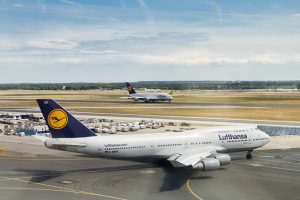
If you’ve ever watched commercial airliners land on a runway, you may recall seeing their engines open up. There are door-like panels on the sides of jet engines. While these panels typically remain closed during takeoffs, they open during landings. What are these panels exactly, and why do they only open during landings?
Reverse Thrust
The panels on the sides of jet engines are used for reverse thrust. Reverse thrust is exactly what it sounds like: a method of propulsion that involves the creation of thrust going backward rather than forward.
Jet engines, of course, work by burning a mixture of fuel and air — much like modern-day automobiles. They feature a combustion chamber. After mixing a precise ratio of fuel and air, a spark is produced in the combustion chamber. This triggers the combustion process. A byproduct of the combustion process is exhaust gases, which are used to propel the airplane forward. As the exhaust gases shoot out the back of the jet engines, forward thrust is created.
Reverse thrust uses this same principle but in reverse. The exhaust gases produced by an airplane’s jet engines are redirected to create reverse thrust. During this process, the sides of the jet engines will open up to facilitate the redirection of exhaust gases.
The Different Types of Reverse Thrust Systems
There are a few different types of reverse thrust systems. One of the most common types is clamshell. Also known as target-type reverse thrust systems, clamshell reverse thrust systems are designed to open like a clamshell. Once opened, they will redirect the engines’ exhaust forward, thereby creating reverse thrust.
There are also cascade-type reverse thrust systems. They are commonly used with high-bypass jet engines. Cascade-type reverse thrust systems leverage the airflow of the engines’ fans to slow down the airplane.
Why Airplanes Use Reverse Thrust When Landing
You might be wondering why airplanes use reverse thrust when landing. Well, reverse thrust is essentially a braking system. Pilots use reverse thrust to slow down when landing.
By using reverse thrust during landings, pilots can also protect various aircraft components, such as mechanical brakes, from excessive wear and tear. Reverse thrust provides a deceleration force while preserving the airplane’s components.
Reverse thrust allows pilots to land on shorter runways. Large airplanes often require long runways on which to land. Using reverse thrust, however, will allow pilots to slow down and come to a complete stop on shorter runways.
- SEO Powered Content & PR Distribution. Get Amplified Today.
- PlatoData.Network Vertical Generative Ai. Empower Yourself. Access Here.
- PlatoAiStream. Web3 Intelligence. Knowledge Amplified. Access Here.
- PlatoESG. Carbon, CleanTech, Energy, Environment, Solar, Waste Management. Access Here.
- PlatoHealth. Biotech and Clinical Trials Intelligence. Access Here.
- Source: https://monroeaerospace.com/blog/why-do-jet-engines-open-up-on-the-runway/



